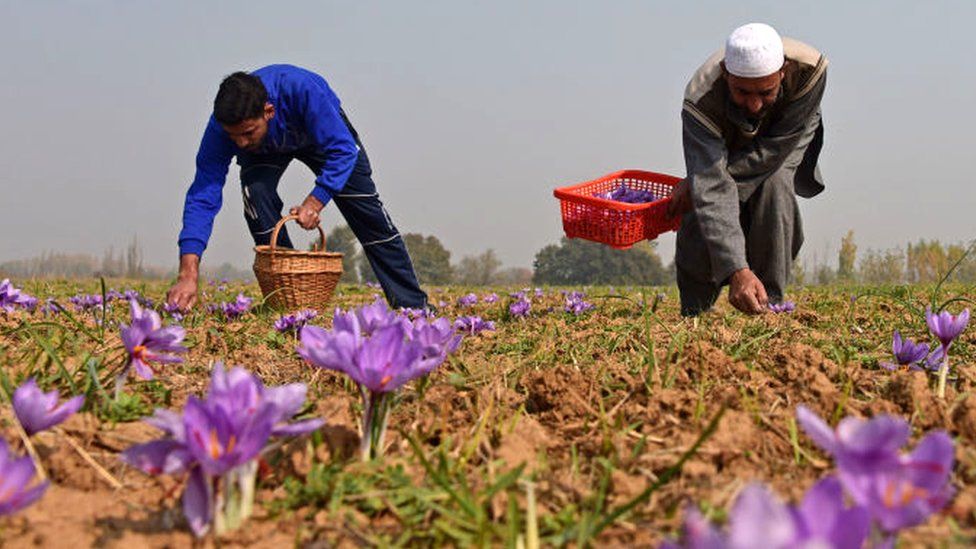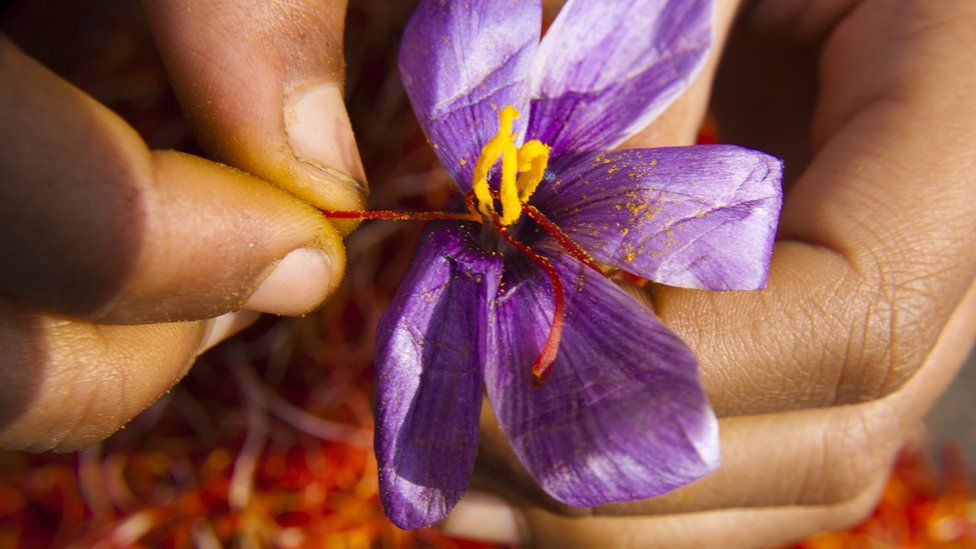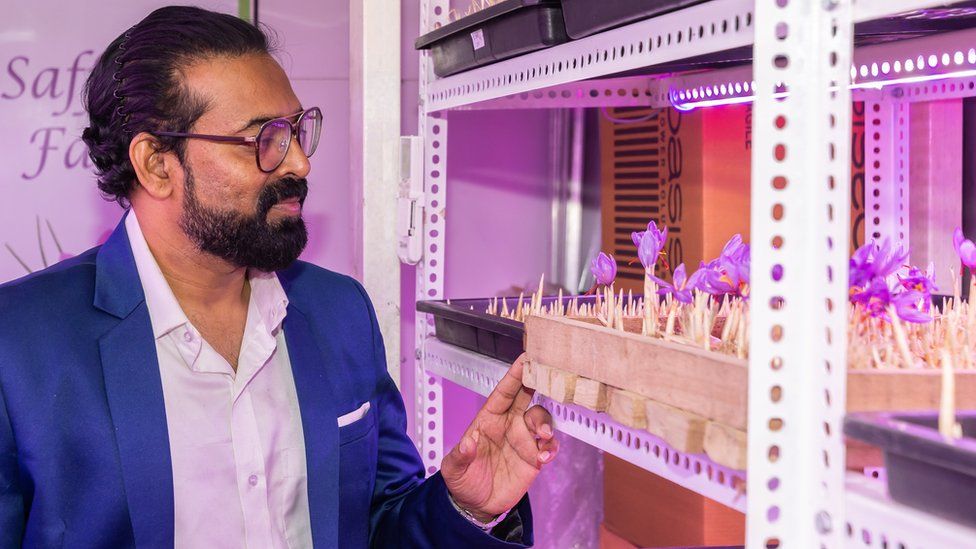‘Red gold’: Why saffron production is dwindling in India

Beneath dramatic snow-capped mountains in Indian-administered Kashmir lies the town of Pampore.
As well as a spectacular location, Pampore is India’s centre for saffron – a spice so valuable that it is sometimes called red gold.
Derived from the crocus plant, saffron fetches around $1,500 (£1,200) per kilo.
In October and November fields around the town turn purple as the crocus plants bloom.
Autumn also sees the intricate work of harvesting, when the deep-red threads, called stigma, are removed from between the crocus petals and dried to form saffron.
Around 90% of India’s saffron production comes from Kashmir, where it has been grown for centuries.
Monis Mir is the fourth generation of his family to be involved in the saffron business.
He says that it can take between 200,000 and 300,000 flowers to produce just 1kg of saffron. It all starts with the planting of corms, which look like bulbs.

“It is a highly labour-intensive industry where each process, from planting the corms, plucking the flowers, gently removing the red stigmas from the flowers, to the final grading, is meticulously carried out by skilled workers with decades of experience in the trade,” he explains.
Mr Mir says his fields have become less productive over the years. He can remember a time when the crocus would flower three to five times in a growing season, now that’s down to two or three.
He blames more erratic patterns of rainfall and higher temperatures, which leaves the soil too dry for the sensitive crocus plant.
Scientist who have studied saffron cultivation agree that conditions have become more difficult.
“Climate change is a reality, creating havoc for saffron fields,” says Dr Bashir Allie, who heads the Saffron Research Station, at Sher-e-Kashmir University of Agricultural Sciences and Technology.
“Rains and the snowfall have become erratic and uncertain. Fields which were very productive just 10 years back don’t produce much saffron now.”
The amount of land devoted to saffron production has dwindled in Indian-administered Kashmir. Around 5,700 hectares was given over to the crop in 1996, by 2020 that had fallen to 1,120.
As well as the changing weather patterns, Mr Mir blames the expansion of towns and villages onto saffron fields, and lack of investment in irrigation and training for farmers.
To revitalise the saffron farmers, Dr Allie is trying to breed hardier crocus plants.
He uses a technique called mutation breeding in which the DNA of the plants is disrupted by exposing seeds to radiation. The hope is that some of the resulting gene mutations will be useful and help the plants prosper in different climatic conditions.
The results have been “encouraging” says Dr Allie.
He is also giving farmers advice on how to make their fields more productive. For example Dr Allie is encouraging them to grow almond trees alongside the saffron, which provide shade and lower the soil temperature.
But some are taking a more radical approach to saffron production.

For 13 years Shailesh Modak was a software engineer based in Pune, 1,400 miles south of Pampore.
Despite being well paid, Mr Modak says he was not happy with his job and in 2016 he decided to quit.
“I had an urge to take my destiny in my hands,” he explains.
His first venture was beekeeping, but that didn’t work out.
“Many of my employees were being stung by bees every day, and transportation was becoming a problem,” he says.


So he switched to saffron production, gambling that he could successfully grow crocus plants in a shipping container.
To meet the exacting needs of the crocus plant the container was fitted with an air conditioning and circulation system. Sensors continually monitor temperature, humidity, CO2 and light levels.
The plants themselves are cultivated in tubes containing moisture and nutrients, rather than soil.
Mr Modak also developed software so all the conditions could be controlled remotely from his phone.
“The biggest problem with agriculture is too much dependency on climate,” he says. “With changes in climate crops fail. So I decided to use the technique of hydroponics – cultivation without soil.”
Last year he devoted half of the container to saffron, which produced 700g. This year the whole container is producing the spice.
“We are in experimental stage – learning to create a environment in which saffron can grow,” he says.

Back in Pampore, Dr Allie has worked on a system which involves growing the crocus inside for part of the year.
Corms are carefully removed from the soil and grown inside for three months before replanted outside just before harvest.
Some farmers have found this a good way to protect the delicate plant and raise productivity.
“In the beginning I was sceptical how saffron can grow in plastic trays,” says Abdul Majeed Wani, a Kashmiri saffron farmer.
“But it has been successful, and the crop has retained the quality, and is much better then saffron grown outdoors.”
However, other farmers say the system is not reliable enough, given the extra work involved.
Saffron farmer Irshad Ahmed experimented with moving the corms indoors in 2021 and 2022, but both times the crops failed. “According to me it’s a waste of time,” he says.
